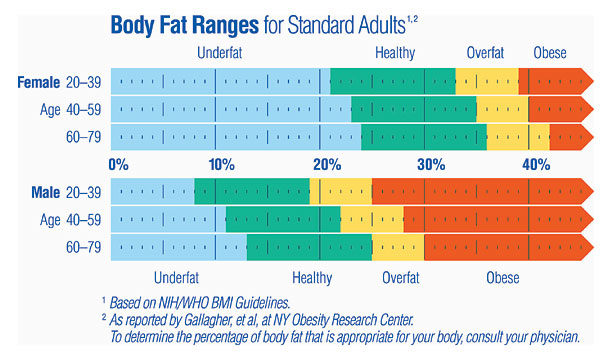|

The chart above is the WHO recommendations for body fat. Their lowest recommended fat percentage is 21% for women
in their 30's. Below this is desirable if you want to look ripped, but not if you want to conceive!
12% is generally thought to be the lowest women could possibly go - going this low is not recommended and has a whole
other set of health problems associated with it.
Body Fat Calculator
Musings and Maths...
Body fat has a density of 0.916 g/cm³. Muscle has a density of 1.04 g/cm³. (these are the figures used when doing hydrostatic
weighing).
This is why people say muscle weighs more than fat. In actual fact, muscle takes up less room for the same
weight (it is more dense) If we take 1lb of fat and convert it to water it would take up a volume of 496 ml. A pound of muscle
would take up 437 ml. It takes up less space. This is why you can lose inches and still weigh the same. Muscle is 22%
denser than fat.
I thought about this a little more. Ice also has a density of 0.9 g/cm³. So if I convert my weight
loss in lbs to ml (9.5 lbs equals 4718 ml) and then freeze it, that is the volume I have lost off my body!
This simplifies
things though, as I have probably lost visceral fat and an element of muscle, but kind of gratifying...
Which method of body fat measurement should I use?
Tanita scales where you stand on them tend to measure your lower body, so if you are a pear shape it ends up higher than
reality. They are also VERY reliant on your height being accurately put in them. Plus if you have clothes on (at a gym), it
will skew the results.
Omron are a type that you hold in your hands, and they tend to do upper body - again if
you are big busted, these tend to give false readings.
If your gym is measuring with either of these they should have
given you a sheet beforehand with advice to get the best readings (don't drink alcohol or caffeine for so many hours, don't
do heavy exercise before hand etc etc).
Your rate of hydration is very important.
You might want to ask your
gym if they do skinfold caliper tests for free. If so, make sure the person doing it is very practiced. They'll measure the
skinfold thickness on your hip, arm and back and come up with a figure from a table. It's not too comfortable (like being
pinched) but it's generally the more accurate method. But as folk need to be trained to use it, a lot of gyms are getting
lazy and just getting the scales as you just stand on them.
Slightly more accurate than Tanita is BIA where a pad is
attached to your foot and to your hand and you lie down. Again you need to do all the recommendations for Tanita or Omron,
but as it measures the whole body it is slightly more accurate.
The best thing to do is to find your method and stick
to it. Personally I have Tanita scales and have gone from over 40% to about 37%. I know from getting a skinfold done that
my real value is about 5% less than the Tanita gives me, so my aim is for 30% rather than the 25% recommended.
What is a realistic amount of body fat to aim to lose?
Tom Venuto suggests a realistic amount to try to lose is 0.5% per week or 0.75-1.5 lbs of fat.
One lb of fat is equivalent to a 3500 calorie deficit.
For example I am currently 155lbs and 38.7% fat. That's about 60lbs of fat and 95lbs of lean (muscle, water, bones,
etc).
There are two ways of looking at fat loss - work out what % body fat you want to be, or work out what weight you
want to be.
A 'healthy' body fat goal for women is 25%. If I manage to maintain all my lean weight (by incorporating weight
training into my regime and never allowing myself to go into starvation mode, whilst consistently creating a calorie deficit),
at 25% body fat I will be 127 lbs.
If however, I decide that my goal weight is 135lbs, assuming I maintain lean mass, my body fat will be 30%. However,
if I increase my lean mass by 6 lbs to 101lbs, at 135lbs weight, I will be 25% body fat.
Assuming I maintain a deficit of 3500 calories per week, to get to 135lbs and 30% body fat, it will take me 20 weeks.
That works out at 0.43% per week - consistent with Tom Venuto's claims.
|
